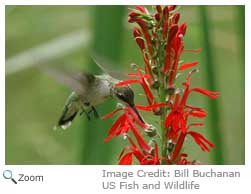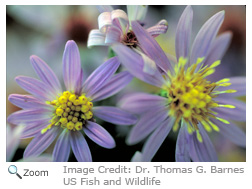There are over 250,000 species of angiosperms. Angiosperms are flowering plants. They make up around 80 percent of all the living plant species on Earth.
Flower Power
Angiosperms are vascular plants. They have stems, roots, and leaves. Unlike gymnosperms, such as conifers and cycads, angiosperm seeds are found in a flower. Angiosperm eggs are fertilized and develop into a seed in an ovary that is usually in a flower. The flowers of angiosperms have male and female reproductive parts.
Pollination  Angiosperms have to undergo a process called pollination before they can reproduce. Angiosperms have male sex organs called stamens. On the end of the stamen is the anther. This is where pollen is made. The pollen has to be taken to the pistil, or the female part of the flower. The pollen is left on the stigma at the end of the pistil. The stigma carries the pollen down a tube called the style to the ovary. Angiosperms have to undergo a process called pollination before they can reproduce. Angiosperms have male sex organs called stamens. On the end of the stamen is the anther. This is where pollen is made. The pollen has to be taken to the pistil, or the female part of the flower. The pollen is left on the stigma at the end of the pistil. The stigma carries the pollen down a tube called the style to the ovary.

|
|
The Birds and the Bees
 Animals like insects and birds can be pollinators. When insects and birds get nectar out of a flower, they pick up some pollen as they move from flower to flower, and they also may leave some pollen behind. Wind also helps move pollen from one flower to another. Animals like insects and birds can be pollinators. When insects and birds get nectar out of a flower, they pick up some pollen as they move from flower to flower, and they also may leave some pollen behind. Wind also helps move pollen from one flower to another.
Dicots
 Angiosperms in this group grow two seed-leaves. Their leaves usually have a single main vein that starts at the base of the leaf blade or three or more main veins that spread out from the base of the leaf. Most plants are dicots, including most trees, shrubs, vines, fruit and vegetable plants, and flowers. There are about 200,000 species of dicots. Angiosperms in this group grow two seed-leaves. Their leaves usually have a single main vein that starts at the base of the leaf blade or three or more main veins that spread out from the base of the leaf. Most plants are dicots, including most trees, shrubs, vines, fruit and vegetable plants, and flowers. There are about 200,000 species of dicots.
Monocots
 These angiosperms start with one seed-leaf. The main veins of their leaves are usually unbranched. There are about 30,000 species of monocots. Monocots include orchids, lilies, irises, palms, grasses, and grains like wheat, corn, and oats. Fruits like dates and bananas also belong to this group. These angiosperms start with one seed-leaf. The main veins of their leaves are usually unbranched. There are about 30,000 species of monocots. Monocots include orchids, lilies, irises, palms, grasses, and grains like wheat, corn, and oats. Fruits like dates and bananas also belong to this group.
|





